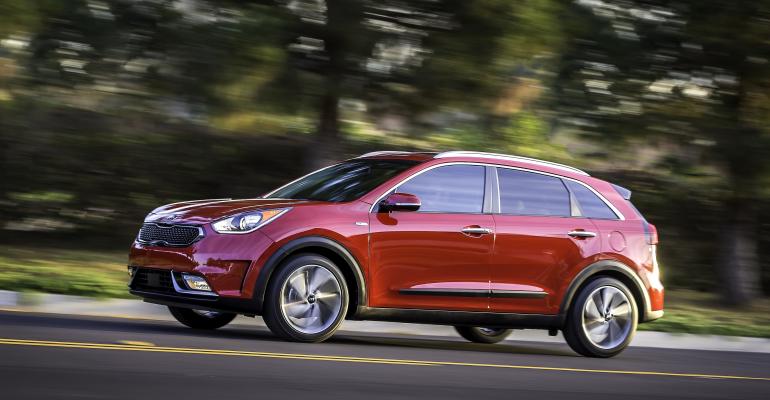CHICAGO – To fulfill a promise of tripling its green-car lineup by 2020, Kia is using the Chicago Auto Show to introduce to America a compact CUV powered by a hybrid powerplant that delivers 50 mpg (4.7 L/100 km).
The new member of the Kia lineup is the ʼ17 Niro, which was teased with a release of sketches in Korea in January and goes on sale in the U.S. early next year, joining the Optima hybrid and battery-powered Soul EV as the green machines in the automaker’s stable.
Since it looks like a CUV but acts like a hybrid, Kia calls Niro an HUV.
“Niro hits the sweet spot by offering the best combination of outstanding (fuel economy), an engaging driving experience, utility, and most importantly, a stunning design that doesn’t shout ‘hybrid,’” says Orth Hedrick, vice president-product planning for Kia Motors America.
“The subcompact CUV market continues to be one of the fastest-growing segments in the world, and Niro offers a uniquely alluring yet practical package that consumers haven’t seen before.”
Unlike most CUVs, Niro initially will be offered only with front-wheel, and not all-wheel, drive. And while initially sold only as a hybrid, a plug-in hybrid version that will operate in battery mode for longer intervals will be added eventually.
The Niro is the first Kia to make use of an all-new, dedicated eco-car platform that sports wide and low proportions with a long roofline and short overhangs. The compact Niro is built on a 106.3-in. (2,700 mm) wheelbase and is larger than a subcompact Kia Soul, shorter than a midsize Kia Sportage.
Niro uses an elevated seating position common with CUVs, and much like the Kia Soul, to provide drivers with a more commanding view of the road as well as easy ingress and egress. The 1.56-kWh lithium-ion battery pack is located underneath the rear seats to allow for increased cabin and cargo space and to retain a flat load floor.
Weight reduction is critical for optimum mileage, so Niro incorporates lightweight seat frames and aluminum hood, tailgate and several suspension elements, including front lower control arms, front and rear knuckles and brake calipers. Even the parking-brake pedal contributes to the weight savings by using fiber-reinforced plastic construction, Kia says.
The Niro is powered by an all-new, Kappa 1.6L GDI 4-cyl., which Kia says was engineered specifically for hybrid applications. Rated at 103 hp, the new engine is the first combination of the Atkinson Cycle, cooled-exhaust-gas recirculation, GDI and a long-stroke-narrow-bore specification to maximize efficiency, Kia says.
Efficiency is maximized and emissions minimized via the exhaust heat recovery system, which speeds engine warm-up by routing coolant to a heat exchanger in the exhaust system.
A 43-hp electric motor works with the gasoline engine to produce 146 hp and 195 lb.-ft. (264 Nm) of torque. Power is transmitted through a newly developed 6-speed dual-clutch transmission.
The Niro will be offered with a host of advanced-technology systems, including blindspot detection with rear cross-traffic alert and lane-change assist; advanced smart cruise control; lane-departure warning; and autonomous emergency braking.
The hybrid also employs what Kia calls an Eco-DAS driver-assistance system featuring its first application of coasting guide and predictive energy control, which is designed to maximize fuel economy by coaching the driver when to coast and brake.
The technology uses the navigation system and cruise control to anticipate topographical changes on the road ahead and manage energy flow accordingly, determining when it’s best to recharge the battery or to expend stored energy, Kia says.





